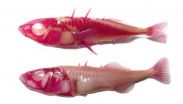(Press-News.org) Tropical Storm Kalmaegi made landfall on September 17 near the border of Vietnam and China and moved inland. Soon after the landfall as a typhoon, NASA's Terra satellite passed overhead and captured an image of the weaker tropical storm.
The MODIS instrument that flies aboard Aqua took a visible picture of Tropical Storm Kalmaegi on Sept. 17 at 03:35 UTC (Sept. 16 at 11:35 p.m. EDT). The image showed the center of the storm in northeastern Vietnam, just south of the China border. Kalmaegi's clouds extended north into southern China and west into Laos.
The Vietnamese National Weather Agency reported that the northern Vietnamese province of Quang Ninh received the brunt of Typhoon Kalmaegi on Tuesday night, Sept. 16. Kalmaegi uprooted trees and damaged crops, in addition to causing damage to homes.
On Sept. 16 at 2100 UTC (5 p.m. EDT), maximum sustained winds were still near 60 knots (69.0 mph/111.1 kph), so Kalmaegi was still a strong tropical storm while moving over land. At that time, the center of the storm was located near 22.3 north latitude and 105.2 east longitude, about 67 nautical miles (77 miles/124 km) north of Hanoi, Vietnam. It was moving to the west-northwest at 20 knots (23.0 mph/37.0 kph).
Kalmaegi is expected to weaken to a depression later on Sept. 17 after it crosses into southern China and moves into the Yunnan Province. The Yunnan Province located in the far southwestern part of China.
INFORMATION:
Rob Gutro
NASA's Goddard Space Flight Center
NASA sees Tropical Storm Kalmaegi weakening over Vietnam
2014-09-17
ELSE PRESS RELEASES FROM THIS DATE:
Size at birth affects risk of adolescent mental health disorders
2014-09-17
New research from the Copenhagen Centre for Social Evolution and Yale University offers compelling support for the general evolutionary theory that birth weight and -length can partially predict the likelihood of being diagnosed with mental health disorders such as autism and schizophrenia later in life. The study analyzed medical records of 1.75 million Danish births, and subsequent hospital diagnoses for up to 30 years, and adjusted for almost all other known risk factors. The study is published today in the Proceedings of the Royal Society, London B.
The number of ...
Artificial 'beaks' that collect water from fog: A drought solution?
2014-09-17
From the most parched areas of Saudi Arabia to water-scarce areas of the western U.S., the idea of harvesting fog for water is catching on. Now, a novel approach to this process could help meet affected communities' needs for the life-essential resource. Scientists describe their new, highly efficient fog collector, inspired by a shorebird's beak, in the journal ACS Applied Materials & Interfaces.
Cheng Luo and his doctoral student, Xin Heng, explain that deserts and semi-arid areas cover about half of the Earth's land masses. In some of these places, trucks bring in ...
Parts of genome without a known function may play a key role in the birth of new proteins
2014-09-17
Researchers in Biomedical Informatics at IMIM (Hospital del Mar Medical Research Institute) and at the Universitat Politècnica de Catalunya (UPC) have recently published a study in eLife showing that RNA called non-coding (IncRNA) plays an important role in the evolution of new proteins, some of which could have important cell functions yet to be discovered.
Ribosomes produce proteins from the instructions found in an RNA molecule. However, only 2% of the human genome is RNA containing information for the synthesis of proteins, meaning it is coding. Other parts of the ...
Iberian pig genome remains unchanged after 5 centuries
2014-09-17
A team of Spanish researchers have obtained the first partial genome sequence of an ancient pig. Extracted from a sixteenth century pig found at the site of the Montsoriu Castle in Girona, the data obtained indicates that this ancient pig is closely related to today's Iberian pig. Researchers also discard the hypothesis that Asian pigs were crossed with modern Iberian pigs.
The study, published in Heredity, sheds new light on evolutionary aspects of pig species, and particularly on that of the Iberian breed, considered to be representative of original European Mediterranean ...
Smoke wafts over the Selway Valley in Idaho
2014-09-17
Smoke from the fires in the Selway Complex is wafting into the Selway River valley in this image taken by the Moderate Resolution Imaging Spectroradiometer (MODIS) aboard the Terra satellite on September 15, 2014. Actively burning areas, detected by MODIS's thermal bands, are outlined in red. All the fires began between August 10 and August 25, 2014 by lightning strikes. The following fires are part of the Selway Complex: Raven Creek, Elevator Mountain, Eagle Creek, Vance Mountain, Nick Wynn, and Jerusalem fires.
The Johnson Bar fire is also contributing to the smoke ...
Slimy fish and the origins of brain development
2014-09-17
Lamprey—slimy, eel-like parasitic fish with tooth-riddled, jawless sucking mouths—are rather disgusting to look at, but thanks to their important position on the vertebrate family tree, they can offer important insights about the evolutionary history of our own brain development, a recent study suggests.
The work appears in a paper in the September 14 advance online issue of the journal Nature.
"Lamprey are one of the most primitive vertebrates alive on Earth today, and by closely studying their genes and developmental characteristics, researchers can learn more about ...
Improved risk identification will aid fertility preservation in young male cancer patients
2014-09-17
(MEMPHIS, TENN. – September 16, 2014) A study led by St. Jude Children's Research Hospital investigators has found the chemotherapy dose threshold below which male childhood cancer survivors are likely to have normal sperm production. The study appears in September 17 edition of the journal Lancet Oncology.
By clarifying which patients are at highest risk for reduced sperm production as adults, researchers expect the findings to eventually increase use of pre-treatment fertility preservation methods such as sperm banking.
The study involved drugs called alkylating agents ...
The rich have more political clout in states, but stricter lobbying rules can narrow gap
2014-09-17
State legislators are more attentive to wealthy citizens' political opinions compared to poor citizens' opinions when making policy decisions, but stricter regulations on professional lobbyists can promote more equal political representation, according to a Baylor University study.
"Stricter lobbying laws are an important tool for ensuring that citizens' opinions receive more equal consideration when elected officials make important policy decisions," said researcher Patrick Flavin, Ph.D., assistant professor of political science in Baylor's College of Arts & Sciences.
The ...
Counting fish teeth reveals regulatory DNA changes behind rapid evolution, adaptation
2014-09-17
Sticklebacks, the roaches of the fish world, are the ideal animal in which to study the genes that control body shape. They've moved from the ocean into tens of thousands of freshwater streams and lakes around the world, each time changing their skeleton to adapt to the new environment.
Breeding studies between marine and freshwater populations of sticklebacks now have turned up one of the genes that controls tooth number, plus evidence that a simple change in that gene's regulation in a freshwater population is associated with a near doubling in the number of teeth. ...
Smart teens rub off on teammates
2014-09-17
A new study of high school activities bears this message for incoming high school students: Play what the smart kids play.
Joining an extra-curricular team or club with members that get good grades can double a high school student's odds of going to college.
And Brigham Young University sociologist and study co-author Lance Erickson knows how to sell the study to teens.
"Tell your parents, whatever they ground you from, it shouldn't be from practice or a club activity," said Erickson. "If they ground you from a school club, you are more likely to end up living at ...



